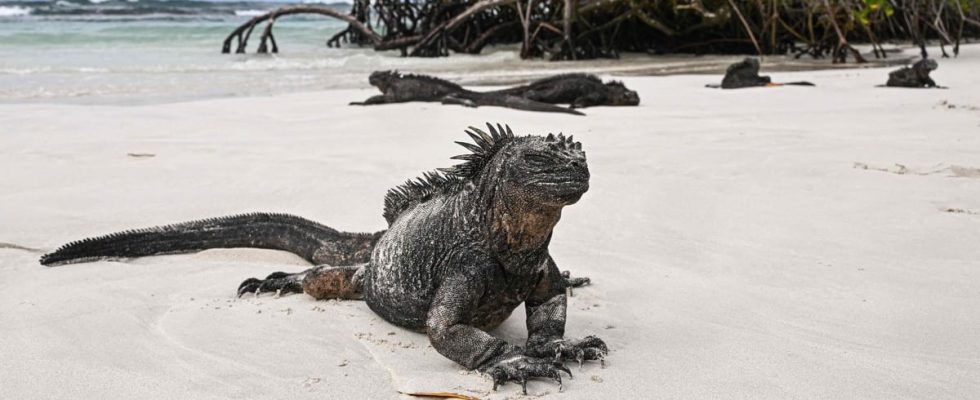Announced intense, the El Niño phenomenon will particularly hit the Ecuadorian archipelago of the Galapagos, one of the places most exposed to the climate crisis, and in particular its vulnerable species, including its exceptional colonies of iguanas.
• Read also: The planet is already beating its daily temperature record set on Monday
• Read also: The El Niño weather phenomenon will be of “at least moderate” strength
On the white sand of the island of Santa Cruz, located 1,000 km off the coast of Ecuador, a number of Amblyrhynchus cristatus jostle.
This unique species of marine iguana, which can live up to 60 years, is one of the most threatened by the increase in ocean surface temperature associated with El Niño, which generates extreme climatic events, weakening winds or generating torrential rains.
“We are in a place where many ocean currents converge, which means that events like El Niño, a product of climate change, have a severe impact on many species and certain ecosystems” of the archipelago, explains Washington Tapia, director of the Galapagos Conservation Society.
Marine iguanas mostly eat seaweed at the edge of beaches “and cannot swim long distances in the open sea to look for (their) food”, which is rare during the El Niño season, he adds.
Photo: AFP
The US Oceanic and Atmospheric Agency (NOAA) announced the start of El Niño on June 8, warning that it “could set new temperature records” in some regions.
And although it is a natural climatic phenomenon which occurs on average every two to seven years and generally lasts between nine and twelve months, the episode takes place “in the context of a climate modified by human activities,” recalls the World Meteorological Organization (WMO).
Weight and height loss
If the intensity and frequency of El Niño vary, the phenomenon “has hit the Galapagos permanently”, explains Danny Rueda, director of the Galapagos National Park, in an interview with AFP.
In 1982, El Niño sounded the first warning before in 1997 it bleached entire colonies of corals and wreaked havoc on the animal species of the islands that inspired the Darwinian theory of evolution.
“According to forecasts, this would be the third El Niño of such magnitude,” worries the park director. At this time of year, he would normally see an “influx of cold water, but we still have a very warm stream of water.”
Galapagos species are able, through resilience, to survive climatic anomalies. But if these variations occur too frequently and with too much intensity, the balance between birth rate and mortality risks being upset.
In the Galapagos, El Niño has in the past reduced the population of penguins and cormorants by 30%, also affecting sea lions and marine iguanas, the four most vulnerable species in the archipelago.
Penguins and cormorants, estimated at between 1,000 to 1,500, could be more affected than marine iguanas, the only ones in the world to have this ability to dive.
This colony of 450,000 reptiles constitutes a “population that can recover very quickly”, notes Mr. Rueda, which does not prevent them from losing weight and shrinking up to five centimeters, as has been documented by the pass.
Heavy rains could affect populations of sea turtles and tortoises, as their nests would be flooded and their eggs lost.
“As it is a natural phenomenon, we have no preventive measures”, the only thing to do is “to have the population figures after nesting to know how much the phenomenon has impacted these vulnerable populations” of the Galapagos, explains Danny Rueda.
Monitoring the animal population will therefore make it possible, a posteriori, to determine the intensity and impact of this new El Niño.
If there is less “reproductive success” of these vulnerable species, explains the director, we “will speak of an El Niño phenomenon (…) in terms of conservation”.
